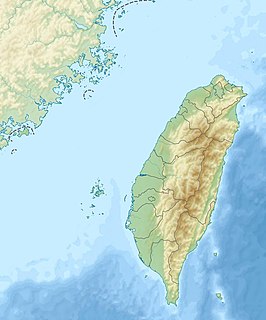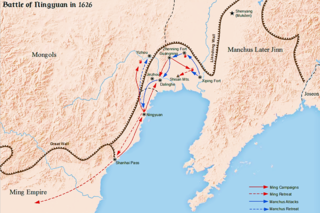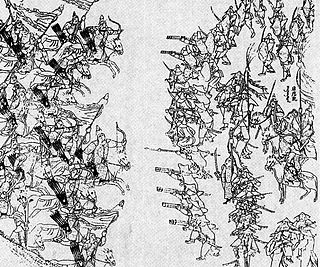 W
WThe Battle of Fort Zhenjiang was a military conflict between the Later Jin and the Ming dynasty. In the fall of 1621 Ming general Mao Wenlong captured Fort Zhenjiang on the border of the Jin-Joseon border and held it against multiple Jin assaults before retreating. Nurhaci burnt down the fort afterwards rather than risk having it captured again.
 W
WThe Battle of Fushun was the first military conflict in the war between the Jurchen-led Later Jin and the Ming dynasty. The battle ended in a decisive victory for the Later Jin and resulted in the capture of Fushun and two other nearby fortresses.
 W
WThe Battle of Guanging was a military conflict between the Manchu forces of the Later Jin and the Ming dynasty of China. It occurred at and around the Ming's northern city of Guangning, which fell to the Later Jin in 1622.
 W
WThe Battle of Kaiyuan was a conflict between the Later Jin and Ming dynasty in the summer of 1619. Following the victory at the Battle of Sarhu, Nurhaci continued the attack on Ming by assaulting the city of Kaiyuan.
 W
WThe Battle of Liaoluo Bay took place in 1633 off the coast of Fujian, China; involving the Dutch East India Company (VOC) and the Chinese Ming dynasty's navies. The battle was fought at the crescent-shaped Liaoluo Bay that forms the southern coast of the island of Kinmen. A Dutch fleet under Admiral Hans Putmans was attempting to control shipping in the Taiwan Strait, while the southern Fujian sea traffic and trade was protected by a fleet under Brigadier General Zheng Zhilong. This was the largest naval encounter between Chinese and European forces before the Opium Wars two hundred years later.
 W
WThe Battle of Ning-Jin was a military conflict between the Later Jin and Ming dynasty. In the spring of 1627 the Jin khan Hong Taiji invaded Ming territory in Liaoning under the pretext of illegal construction on Jin lands.
 W
WThe Battle of Ningyuan was a battle between the Ming dynasty and the Jurchen Later Jin in 1626. The Jurchen Later Jin had been waging war on the Ming for several years, and their leader Nurhaci had deemed Ningyuan to be a suitable target for his attack, in part due to advice from a Chinese defector, Li Yongfang. Later Jin failed to take the city and Nurhaci was wounded in the assault, dying eight months later. The Ming emerged victorious, marking a temporary resurgence of the Ming army after an eight-year-long series of defeats.
 W
WThe Battle of Sarhū refers to a series of battles between the Later Jin dynasty and the Ming dynasty and their Joseon allies in the winter of 1619. The battle is notable for the heavy use of cavalry by the Later Jin in defeating Ming and Joseon forces equipped with hand cannons, cannons, and matchlocks.
 W
WThe Battle of Shen-Liao was a military conflict between the Later Jin and the Ming dynasty. In early 1621 Nurhaci, khan of the Later Jin, invaded Liaodong and captured the cities of Shenyang and Liaoyang from the Ming.
 W
WThe Siege of Fort Zeelandia of 1661–1662 ended the Dutch East India Company's rule over Taiwan and began the Kingdom of Tungning's rule over the island. Taiwanese scholar Lu Chien-jung described this event as "a war that determined the fate of Taiwan in the four hundred years that followed".
 W
WThe Battle of Tốt Động – Chúc Động (1426) was the decisive battle in the 14-year Lam Sơn uprising which established Vietnam's independence from Ming China in 1428. The battle took place over three days from 5–7 November 1426 in the Red River Valley between Tốt Động and Chúc Động, two villages of Chương Mỹ District, near Hanoi. Lê Lợi's forces routed the Ming army. Lam Son army had reused the remnant hand cannons of the previous Trần Dynasty in Thanh Hoa effectively against the enemy, caused very high casualties to the Ming army.
 W
WThe Tumu Crisis, also called the Crisis of Tumu Fortress or Battle of Tumu, was a frontier conflict between the Oirat tribes of Mongols and the Chinese Ming dynasty which led to the capture of the Emperor Yingzong of Ming on September 1, 1449, and the defeat of an army of 500,000 men by a much smaller force.
 W
WThe Battle of Xicheng was a military conflict between the Yehe Jurchens, their Ming allies, and the Later Jin. In the fall of 1619 Nurhaci invaded Xicheng, the home of the Yehe Jurchens. Nurhaci personally led the vanguard and took the east wall. After capturing the city the Yehe inhabitants were spared, but their Ming allies who had fought beside them were executed.